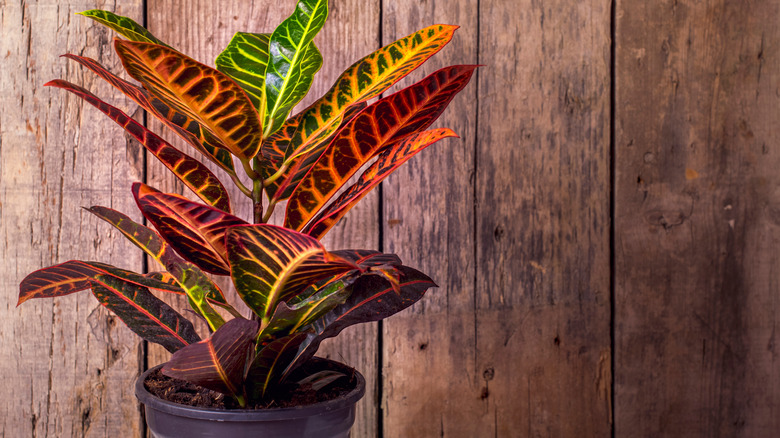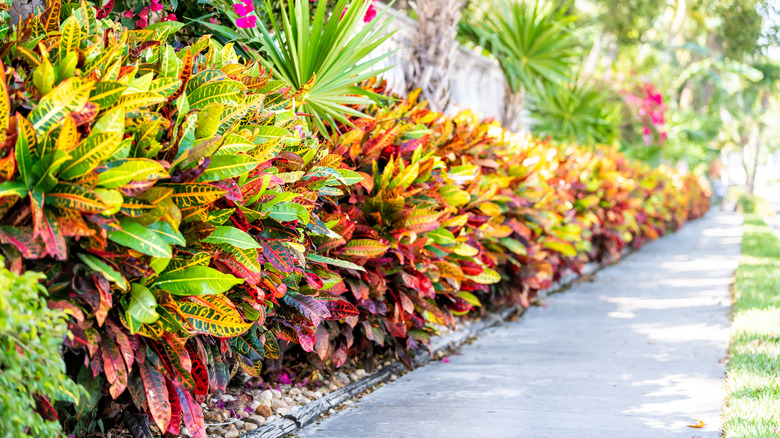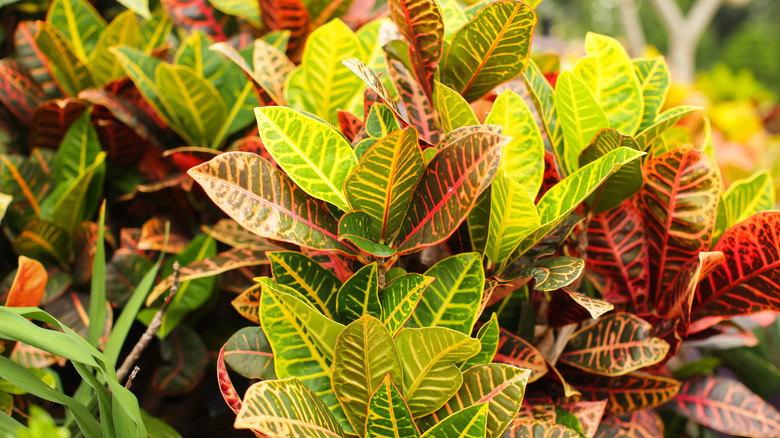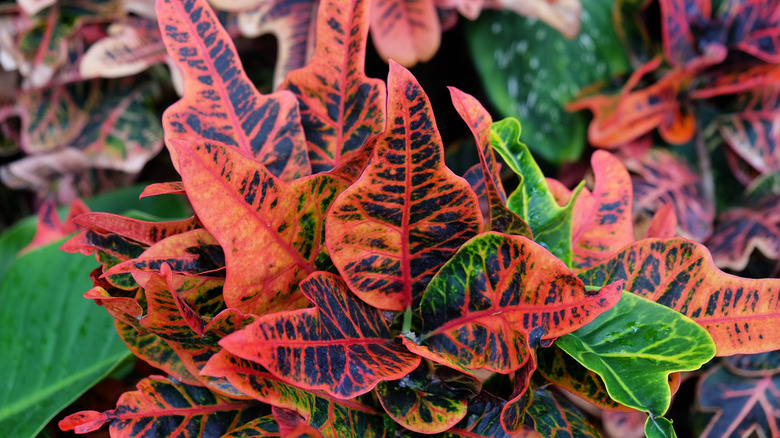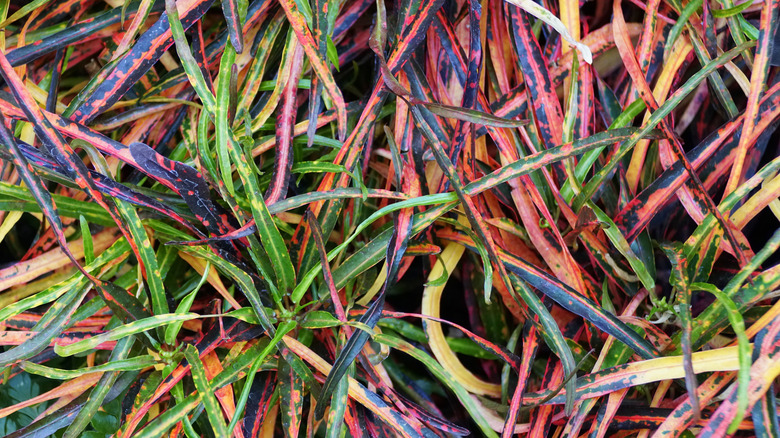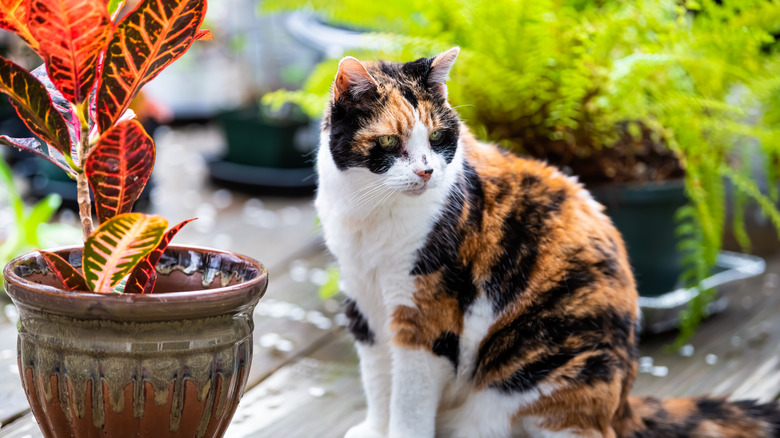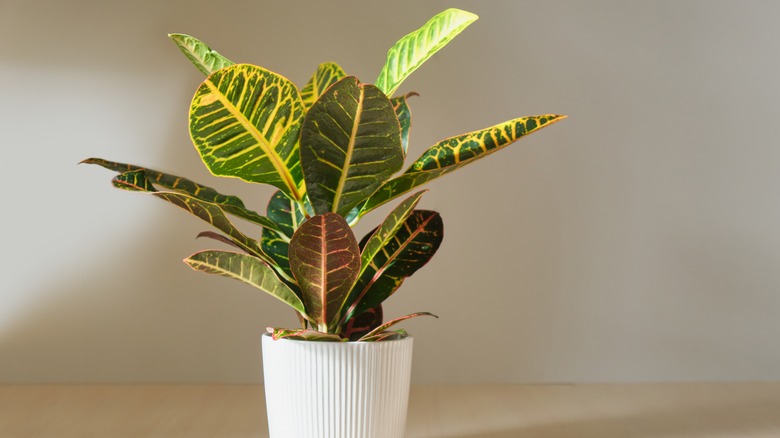Croton Plants: Everything You Should Know Before Planting
Codiaeum variegatum, also known as croton plant, garden croton, and variegated croton, is native to the tropical regions of Asia and the islands of the western Pacific Ocean, as per The Spruce. You can identify a croton plant by its large, leathery variegated leaves, which can grow up to 11 inches tall and as wide as 3 inches. These leaves, depending on the cultivar, may appear blue-green, pink, red, orange, or yellow. The plant itself may reach almost 9 feet tall in ideal conditions, though it grows quite slowly.
This monoecious shrub is most often grown in the United States in USDA zones 11 or 12 and can be grown indoors and outdoors with much effort. It can be particularly challenging to grow this plant indoors as it needs lots of humidity and temperatures that stay above 60 degrees Fahrenheit, as told by Garden Lovers Club. Growing it outdoors will be slightly easier, especially if you live in a state that has a tropical environment, such as Florida.
How to use croton plants in the garden
Croton plants grow happiest in the garden, as we've mentioned. In tropical climates, you may see them planted underneath trees, in containers, as short hedges, or planted alongside annuals. Garden croton typically have a difficult time reaching heights taller than 3 feet, according to North Carolina State Extension, which is something you should keep in mind before choosing a spot to plant yours. There are several different varieties of croton plants that pair well with countless other plants. You can research all these cultivars to see which type will pair best with your existing landscape.
If you live in a colder state, you still have the option to keep your croton plants outdoors during the summer. However, you should make sure that they are in containers that you can move inside when the temperatures are expected to drop below 50 degrees Fahrenheit. Potted croton plants can be more manageable than garden-planted ones as gardeners can more easily control their growth habits so they don't become too large.
How to grow croton plants
Garden croton can be grown from young plants you can purchase at a nursery, or they can be propagated from cuttings. You shouldn't have to buy much more than a pot and some additional potting soil, but if you plan to propagate your plant, you'll need additional supplies. Specifically, you'll need sterile scissors, a mature croton plant, neutral and well-draining potting soil, a small pot, and rooting hormone, as explained by The Spruce.
To begin the propagation process, start by cutting a stem with three leaves right above a leaf node that is at least 4 inches in length. Then, remove the bottom leaves and dip the cut end into the rooting hormone. Fill a small pot with your potting soil, moisten it, and press a hole into the center of the soil with your little finger that is 1 to 2 inches deep. Place the stem of your cutting into the hole and firm the dirt around it to keep it upright. Next, put a plastic bag over the croton cutting before finding a sunny spot to place it in. Take the bag off after a week and continue to keep the soil moist. After no more than four weeks have passed, the stem should have taken root.
How to care for croton plants
Before deciding to care for a croton plant, you should know that they need quite a bit of attention to stay alive. They need very specific conditions in order to show off their beautifully colored leaves. The most important of the care instructions is humidity, as mentioned before. When growing variegated croton indoors as a houseplant, you can place a humidifier near your plant. Or, as a cheaper option, Almanac suggests misting the leaves of the garden croton weekly or placing a tray of water and gravel near the plant. On top of keeping your croton humid, it will also need to be watered each time the first 2 inches of soil dries out.
You already know that croton plants enjoy temperatures of about 70 degrees Fahrenheit, but it should also be mentioned that these beauties have specific sunlight requirements too. According to Garden Lovers Club, the plant needs at least six hours of direct sunlight per day to maintain its colorful leaves. This won't be hard to achieve if you make sure to keep your croton plant in an east- or west-facing window. While a shadier spot won't necessarily kill your garden croton, it will lead to less variegation on the leaves.
Croton plant varieties
From the Euphorbiaceae family, Codiaeum variegatum has at least 100 different cultivars. Many are so similar to one another that they can be difficult to tell apart, but others are so different that you'd never know they were of the same species. As told by Almanac, varieties of variegated croton are native to the tropical regions of Asia and Oceania, and they grow quite easily outdoors in other tropical climates. Many of the plant's varieties would make great additions to your tropical garden. Here are five of the best, as described by Balcony Garden Web.
-
Codiaeum variegatum "Petra" is specifically native to Southeast Asia. It is one of the most popular varieties, and it can grow up to 5 feet tall.
-
Codiaeum variegatum "Gold Star" is an extremely slow-growing variety of croton that features bright green leaves splattered with dots of yellow.
-
Codiaeum variegatum "Zanzibar" has much narrower leaves compared to other types of croton plants. Its bushy, hair-like shape may be shades of red, green, purple, or orange.
-
Codiaeum variegatum "Oakleaf" is a colorful cultivar of croton that has leaves that include three different colors that may be red, green, orange, or yellow.
-
Codiaeum variegatum var. "Pictum" is also known as superstar croton because of its gorgeous yellow-spotted leaves and tall, upright shape.
Are croton plants toxic?
Croton plants are unfortunately toxic to humans and pets, as per Garden Lovers Club. Inside the leaves and stems of this unique plant is a white latex sap that can cause dermatitis when it comes into contact with skin. This sap can also poison humans and pets if ingested. Digestion distress caused by croton plant sap is not typically fatal for pets or children, especially if medical attention is sought immediately.
If you plan to keep a croton plant in your home when children, cats, or dogs are present, make sure that it is situated out of their reach. These plants can thrive on high shelves as long as they have access to adequate humidity and sunlight. Though the plant is very attractive, it is not worth a trip to the emergency vet or hospital when your pet or child gets ahold of one of its leaves.
How to repot croton plants
Repotting variegated croton isn't much different from repotting any other kind of leafy plant. As a slow-growing evergreen shrub, it won't need to be repotted often. Instead of following an exact timeline to figure out when to repot, you should check its drainage hole regularly. If you notice any emerging roots, you'll know it's time.
When your croton plant is ready to be repotted, you'll need to gather some materials. The Spruce recommends finding a pot that is just one size bigger than the last in addition to neutral, well-draining potting soil. You might also consider using gloves to protect yourself from the plant's toxic sap. To start, gently take your croton plant out of its original pot and knock away any excess soil to expose its roots. If you allow your plant to dry out slightly before doing this, it will be easier to remove. Next, fill its new pot with some soil before placing the croton in as well. Backfill with more soil and pack it down carefully until your plant is secure. Finally, water the variegated croton generously before moving it back to a sunny window.
